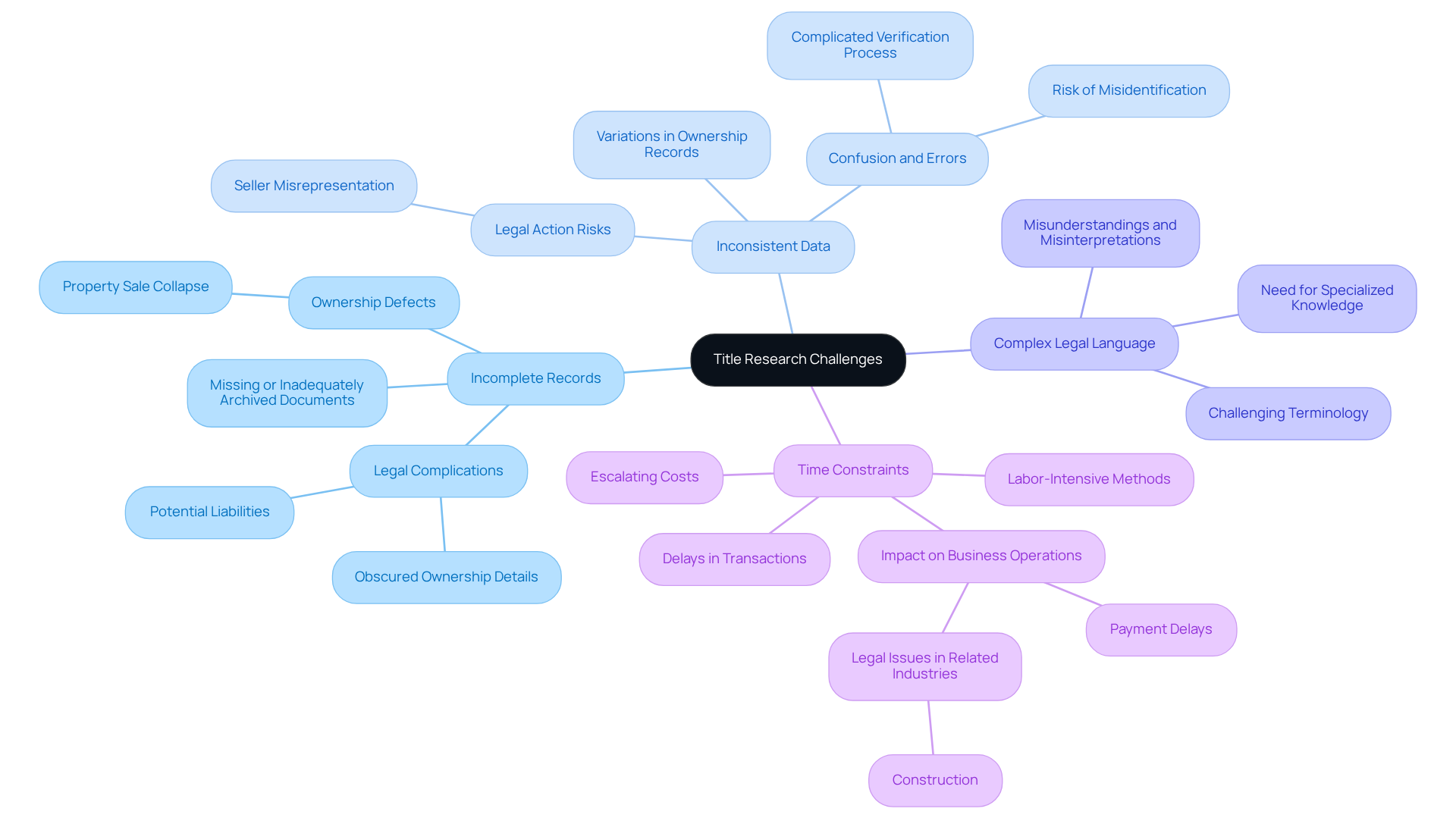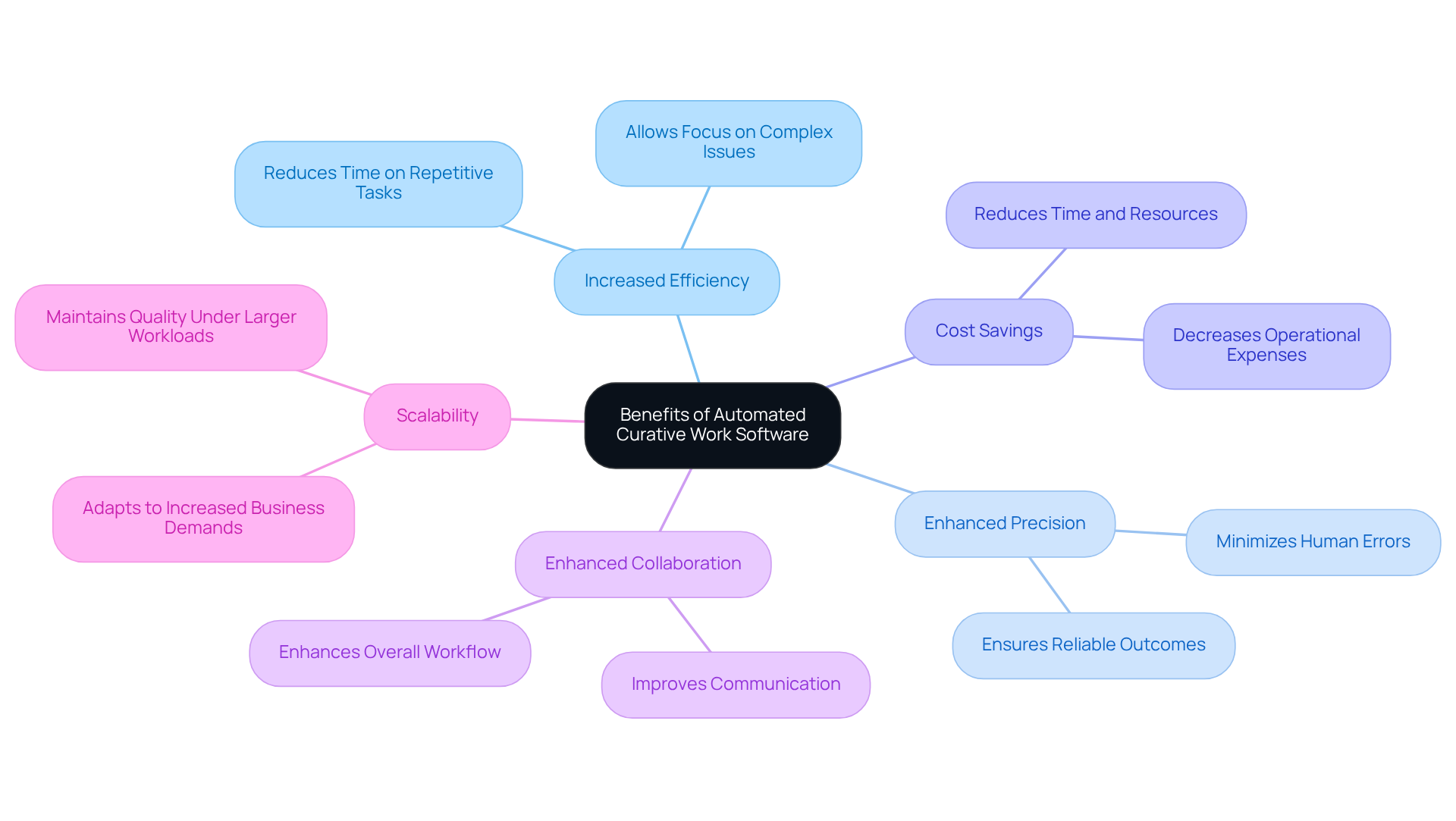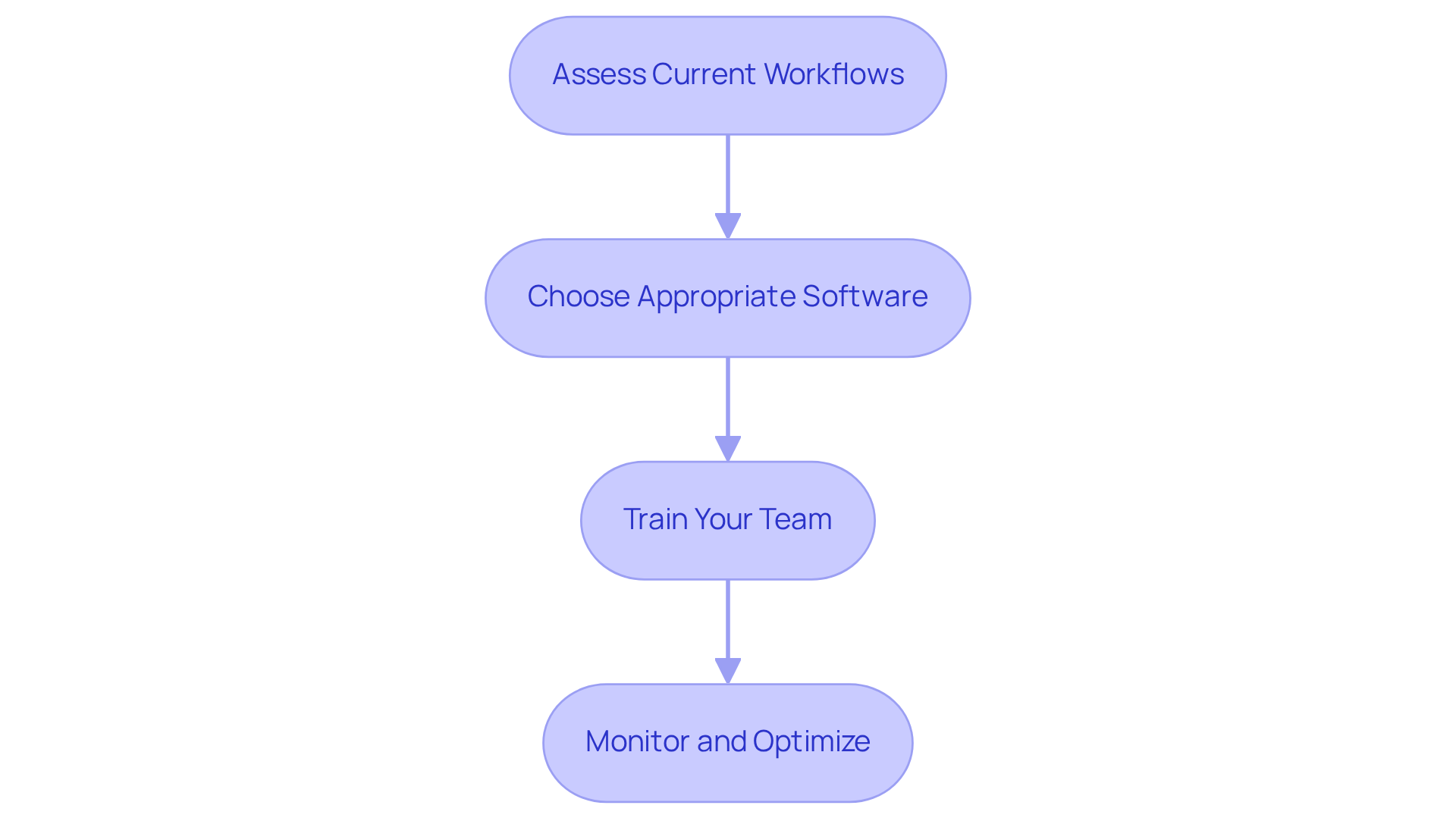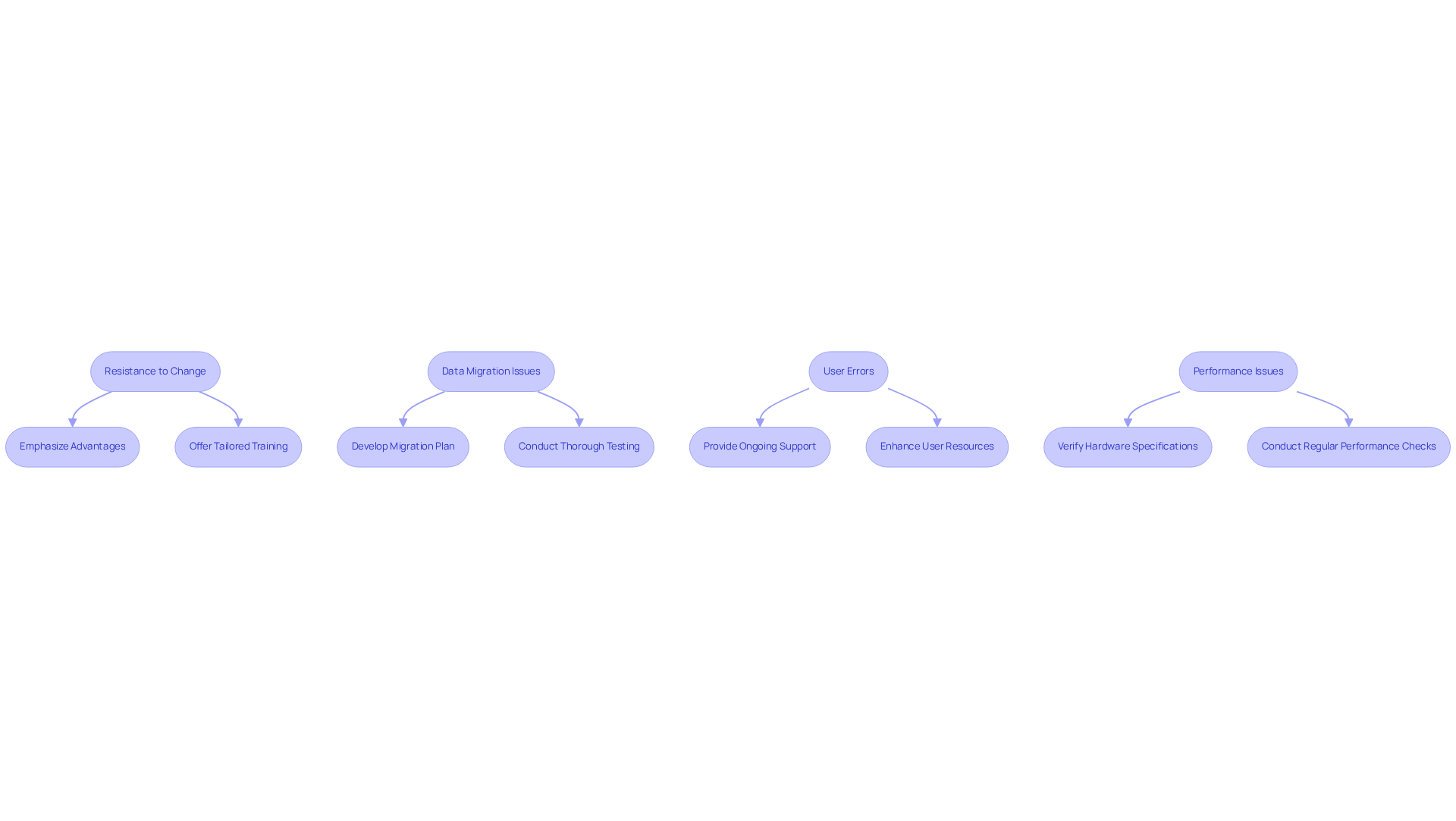Overview
This article delves into the crucial steps required to implement automated curative work software within title research workflows. It presents a clear four-step process:
- Assessing current workflows
- Selecting suitable software
- Training the team
- Monitoring performance
Furthermore, it underscores the substantial benefits that automation brings, including increased efficiency, precision, cost savings, and improved collaboration. These advantages are essential in addressing the common challenges encountered in title research, ultimately paving the way for enhanced operational effectiveness.
Introduction
Title research presents a myriad of complexities that can hinder transactions and result in significant legal repercussions. As real estate professionals contend with incomplete records, inconsistent data, and convoluted legal terminology, the necessity for a streamlined solution becomes increasingly evident. This article explores the transformative advantages of automated curative work software, providing a step-by-step guide for implementation that promises to improve both efficiency and accuracy in title research. However, how can organizations navigate the inherent challenges of embracing new technology, and what strategies will guarantee a successful transition?
Understand Title Research Challenges
Title research presents numerous challenges that can significantly impede both efficiency and accuracy. Key issues include:
- : A substantial number of title documents may be missing or inadequately archived, resulting in critical gaps in information. This can lead to , as may obscure ownership details and create potential liabilities. For instance, incomplete or flawed chain of ownership information can result in ownership defects that may cause a property sale to collapse.
- Inconsistent Data: Variations in property ownership records can introduce confusion and errors during title searches. Discrepancies in how names or property descriptions are recorded can complicate the verification process, increasing the risk of misidentification. Furthermore, this inconsistency may also result in potential legal action if a seller misrepresents their ownership of a property.
- : The legal terminology prevalent in ownership documents can be challenging to navigate, necessitating specialized knowledge that many professionals may lack. This complexity can result in misunderstandings and misinterpretations, further complicating the research involved. As Carly Fiorina noted, "The goal is to transform data into information, and information into insight," highlighting the need for clarity in legal documentation.
- Time Constraints: Traditional are often labor-intensive and time-consuming, which can delay transactions and escalate costs. The inefficiencies inherent in manual methods can hinder timely decision-making, affecting overall business operations. Incomplete documentation can also lead to payment delays and potential legal issues in related industries, such as construction.
Recognizing these challenges underscores the importance of adopting solutions. By leveraging technology, real estate professionals can use automated curative work software to streamline their workflows, , and ultimately .

Explore Benefits of Automated Curative Work Software
The title research process is significantly enhanced by the benefits presented by .
- Increased efficiency results from , which reduces the time spent on repetitive tasks, allowing title researchers to focus on more complex issues.
- : By minimizing human errors through the use of automated curative work software for data extraction and analysis, the program ensures more reliable outcomes.
- reduces the time and resources required for property research, leading to decreased operational expenses for real estate professionals.
- : Automated curative work software improves communication and data sharing among team members, thereby enhancing overall workflow.
- Scalability: As business demands increase, the use of automated curative work software can seamlessly adapt to without sacrificing quality.

Implement Automated Software in Title Research Workflows
To effectively implement in title research workflows, adhere to the following steps:
- Assess Current Workflows: Begin by evaluating existing processes to pinpoint areas ripe for automation. Focus on repetitive tasks that consume substantial time; studies indicate that 51% of employees spend at least two hours daily on such tasks, highlighting the potential for . Automation can improve efficiency by 40-60%, making it crucial to identify these opportunities.
- Conduct thorough research to choose the appropriate program by identifying automated curative work software that meets your specific requirements. Key considerations should include user-friendliness, integration capabilities with existing systems, and the quality of customer support. , including an example manager that allows for quick annotation of documents, significantly enhancing operational efficiency. The right choice can lead to , as evidenced by organizations that save an average of $46,000 annually through the use of automated curative work software.
- Train Your Team: Ensure on the new system. Offering sufficient resources and continuous support is essential for a seamless transition and optimizing the application's advantages. Effective training can lead to a 67% faster hiring and onboarding process, further streamlining operations and ensuring that your team is well-equipped to leverage the new tools, including Parse AI's interactive labeling and OCR technology.
- Monitor and Optimize: After implementation, continuously observe the system's performance and request feedback from users. This iterative approach allows for necessary adjustments to and resolve any emerging issues. Organizations that embrace this feedback loop often experience and reduced operational costs, reinforcing the value of automation in title research.

Troubleshoot Common Implementation Issues
Utilizing can significantly enhance efficiency; however, various challenges may arise. Below are common issues along with strategies to troubleshoot them:
- : Team members often hesitate to adopt new technology. To alleviate this, emphasize the advantages of the application and offer thorough training customized to particular roles. This approach can result in a 21% increase in profits associated with employee involvement during change management activities. Engaging employees in the change process can significantly reduce resistance. must be addressed to ensure that can seamlessly integrate with existing systems, which is crucial. Collaborate with IT experts to resolve compatibility challenges. Notably, 39% of organizations indicate that integrations are the most critical aspect when choosing a service provider. Additionally, 83% of organizations view automated curative work software integrations as one of their biggest priorities, underscoring the need to address these challenges effectively. Furthermore, 59% of organizations cite integrations as instrumental in improving their close rates.
- : Transferring data from legacy systems can pose significant challenges. Develop a detailed migration plan and conduct thorough testing to maintain data integrity. Inadequate planning can lead to unrealistic expectations and implementation failures.
- : Initial user errors are common as team members acclimate to the new system. Offer ongoing support and resources to facilitate their adaptation, which can reduce resistance and enhance the overall user experience.
- : If the software experiences slowness or unresponsiveness, verify that your hardware meets the necessary specifications. Regular performance checks can help identify and resolve potential bottlenecks early in the implementation process.

Conclusion
The implementation of automated curative work software represents a transformative step for real estate professionals aiming to enhance the efficiency and accuracy of title research workflows. By addressing common challenges associated with title research—such as incomplete records, inconsistent data, and time constraints—automated solutions can significantly streamline processes and mitigate legal risks.
Key strategies for successful implementation are outlined, including:
- Assessing current workflows
- Selecting the right software
- Training team members
- Monitoring performance
Each step is crucial for ensuring a smooth transition to automated systems, ultimately leading to increased efficiency, cost savings, and enhanced collaboration among team members.
Embracing automated curative work software not only addresses the immediate challenges faced in title research but also positions real estate professionals for long-term success in a competitive market. By proactively integrating these technologies, organizations can foster a culture of innovation, improve transaction speed, and enhance overall productivity. The time to act is now—invest in automation to unlock the full potential of title research and stay ahead in the ever-evolving landscape of real estate.
Frequently Asked Questions
What are the main challenges faced in title research?
The main challenges in title research include incomplete records, inconsistent data, complex legal language, and time constraints.
How do incomplete records affect title research?
Incomplete records can lead to critical gaps in information, resulting in legal complications such as obscured ownership details and potential liabilities, which may cause property sales to collapse.
What issues arise from inconsistent data in property ownership records?
Inconsistent data can introduce confusion and errors during title searches, complicating the verification process and increasing the risk of misidentification, which may lead to potential legal action.
Why is complex legal language a challenge in title research?
The complex legal terminology in ownership documents can be difficult to navigate, requiring specialized knowledge that many professionals may not possess, leading to misunderstandings and misinterpretations.
How do time constraints impact title research?
Time constraints can delay transactions and escalate costs due to the labor-intensive and time-consuming nature of traditional title research methods, hindering timely decision-making and potentially causing payment delays.
What solutions are suggested to address the challenges of title research?
The article suggests adopting automated curative work software solutions to streamline workflows, enhance accuracy, and improve transaction efficiency for real estate professionals.




